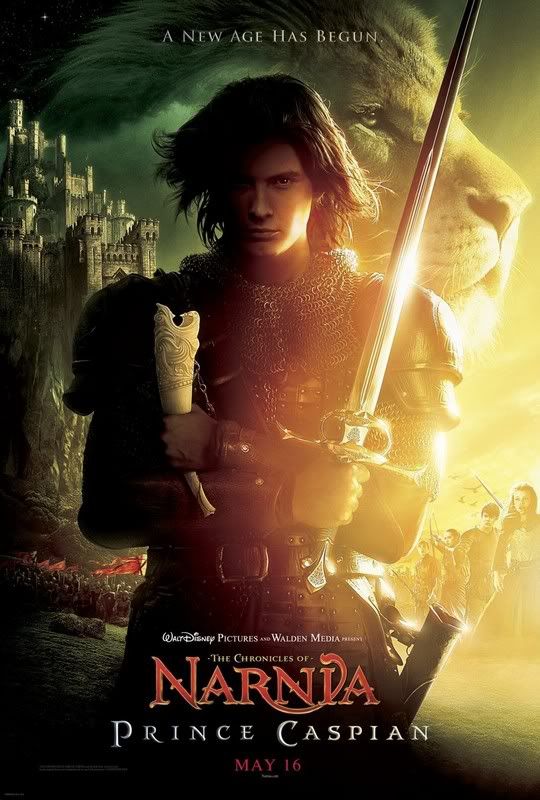Richard Taylor blogs on Armor and Weaponry of Prince Caspian
Weta Workshop on Prince Caspian
Narnia had changed since both we and the Pevensie children had last visited. While elements of the Narnia we knew were still present, a whole new culture had to be designed and created and even the familiar Narnians had changed and required new work.
Weta Workshop provided new design work in the form of environmental concepts and armor and weaponry designs, working closely with Director Andrew Adamson and the Los Angeles creative team leaders, Production Designer Roger Ford and Costumer Designer Isis Mussenden. The Pevensie children required new elements to compliment their royal gear from the first adventure and the look of the Narnians' armor and weapons had to be evolved in a new direction since we last saw it. In addition the Telmarine culture had to be conceived from scratch and a great deal of work was done in the quest to find their unique design signature.
Weta's armor and weapons departments were kept busy turning these concepts into reality and in sufficient numbers to arm two opposing armies. For the Telmarines Weta made two-hundred polearms in two different styles, two-hundred rapiers of varying design, over a hundred falchions, two-hundred and fifty shields and fifty-five crossbows. The Telmarine cavalry were equipped with soft shields and stunt gear for use with live horses. Weta made stunt-safe horse faceplates for the warhorses and sculpted unusual faceplate helmets for the soldiers.
Befitting rulers of a vast kingdom, Miraz and his lords needed special weaponry. Weta created individual swords, scabbards and sculpted faceplate helmets for the featured lords including Glozelle, who also had a beautiful dagger. Miraz himself had a special shield, sword, scabbard, full plate armor and an ornate faceplate helmet.
Hero Prince Caspian needed a sword, a variant of the Royal guard swords made, while Weta also made prop weapons for specific scenes, including a crossbow for Prunaprismia's room.
Among the children's equipment, which had to be refitted and restored after The Lion, the Witch and the Wardrobe, Weta made new armor for Edmund and a new vambrace for Susan.
New characters Nikabrik and Trumpkin needed swords and daggers, while the grand Narnian army seen in the first film had to be aged back and re-imagined as a rebel force, gone wild. Familiar armor and weaponry was mixed with new elements to create a more organic, individualized and heavily worn look. New items added included a Minotaur mace and Centaur flail as well as specific weapons for the lead Minotaur, Asterius.
Even Reepicheep, who would be a digital character, required an exquisite little sword to be made by Weta at life size.
In addition, Weta's miniatures department was tapped to provide highly detailed 1/24th and 1/100th scale miniatures of Miraz's great castle and its environment.
Richard Taylor
Weta Workshop
BIO
WETA WORKSHOP (armor/weapon designs and fabrication) is a multi-faceted effects company based in Wellington, New Zealand, which produces effects for television and film. Founded in 1986 by five-time Academy Award® winner Richard Taylor and partner Tania Rodger, Weta has produced creature and makeup effects for all of Peter Jackson's films, including his Oscar-winning "Lord of the Rings" trilogy," "Meet The Feebles," "The Frighteners," "Braindead," "King Kong" and "Heavenly Creatures."
Taylor, along with the firm's innovative co-founder and partner, Rodger, won four Academy Awards® for his contributions to "Lord of the Rings" -- Best Visual Effects and Best Makeup for "Fellowship of the Ring" (in addition to a nomination for Best Costume Design) and Best Costume Design and Best Makeup on "Return of the King." He won British Academy (BAFTA) Awards for Best Costume Design on "The Two Towers" and Best Visual Effects and Best Makeup on "The Fellowship of the Ring," and earned additional nominations for Best Makeup on "The Two Towers" and "Return of the King" and Best Costume Design on "Return of the King." On his most recent collaboration with Jackson, Taylor won his fifth Oscar® and another BAFTA honor for Best Visual Effects on "King Kong," Jackson's epic retelling of the 1933 horror classic.
Taylor grew up in Te Hihi, near Pukekohe, New Zealand. He first attended Wesley College in Pukekohe before winning a spot at the Wellington School of Design. Upon graduation, he first designed board games for a Wellington design studio before joining a local television studio, where he became a model maker for TV spots. His work attracted budding filmmaker Jackson's attention, and they first joined forces on his 1989 debut feature, "Meet the Feebles."
Labels: armor, prince caspian, richard taylor, weapons, weta workshop




0 Comments:
Post a Comment
<< Home